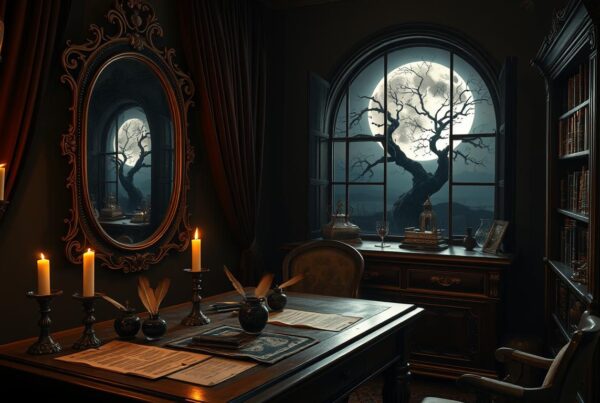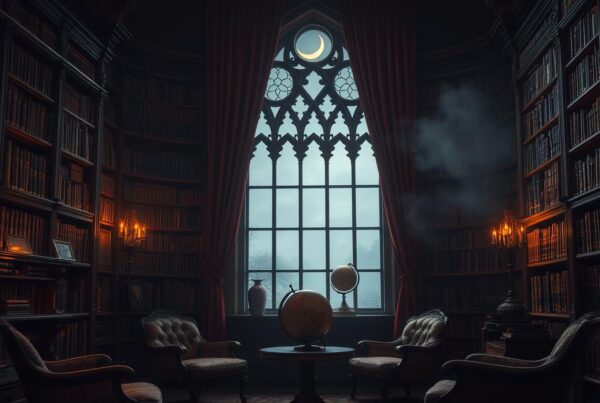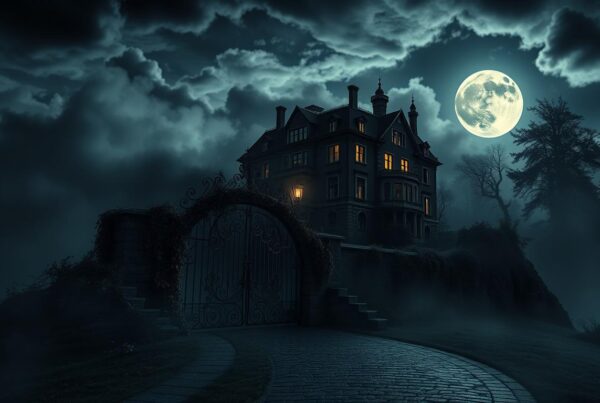Gothic romance novels take readers to spooky places. These stories come to life with their settings. Places like gloomy castles, misty moors, and dark forests create thrilling tales of love and mystery.
The power of place in Gothic romance is huge. Each eerie location shapes the mood and moves the story along. From isolated mansions to stormy seas, these settings become characters themselves.
Let’s dive into how these settings shape the genre. We’ll look at the secrets behind Gothic romance’s most famous places. And how they keep readers’ imaginations alive.
The Essence of Gothic Romance in Literature
Gothic literature is a captivating genre that has fascinated readers for centuries. It emerged in the late 18th century. It combines romance with eerie and supernatural themes.
Gothic novels take readers to a world of ancient castles and gloomy landscapes. They reveal haunting secrets.
Defining Gothic Romance
Gothic romance mixes love stories with horror and suspense. This unique blend creates tension and intrigue. It keeps readers on the edge of their seats.
The genre explores passion, fear, and the unknown. It delves into human emotions and the supernatural realm.
Key Elements of Gothic Fiction
Dark romanticism is a key feature of Gothic fiction. Writers use vivid descriptions to create foreboding scenes. This creates an atmosphere of dread.
Supernatural elements are crucial, with ghosts and monsters lurking in the shadows. Gothic stories feature brooding heroes and vulnerable heroines. They also have sinister villains, each with their own demons.
The Role of Setting in Gothic Narratives
Setting is vital in Gothic literature. Crumbling castles and misty moors are more than backdrops. They become characters that influence the plot and characters’ fates.
The eerie ambiance of Gothic settings adds to the mystery and danger. It draws readers deeper into the dark and twisted world.
Atmospheric Settings: How Location Shapes Gothic Romance
Gothic romance stories live and breathe because of their settings. These settings do more than just set the scene. They create a Gothic feel that fills every part of the story. Think crumbling castles and misty moors.
The settings in Gothic stories deeply affect the story. Stormy nights and gloomy forests show the characters’ inner struggles. These settings make the story tense and full of mystery.
In Gothic romance, the setting is like a character. Haunted mansions with secret rooms are perfect for hiding. Foggy cities hide mysterious figures.
Writers aim to make readers feel certain ways through settings. A lonely estate makes you feel scared and weak. A tight castle makes you anxious and paranoid.
By choosing their settings wisely, Gothic authors create worlds that pull you in. The role of location in these stories is huge. It’s what makes Gothic romance so special.
The Haunted Castle: Cornerstone of Gothic Ambiance
Haunted castles are key symbols in Gothic romance. They draw readers in with their spooky charm. These medieval settings are perfect for telling mysterious and supernatural tales.
Historical Significance of Castles in Gothic Literature
Gothic architecture sets the mood for scary stories. Castles, with their deep history and grand look, make us feel both amazed and scared. Writers use real-life castles as inspiration, making their stories feel real and deep.
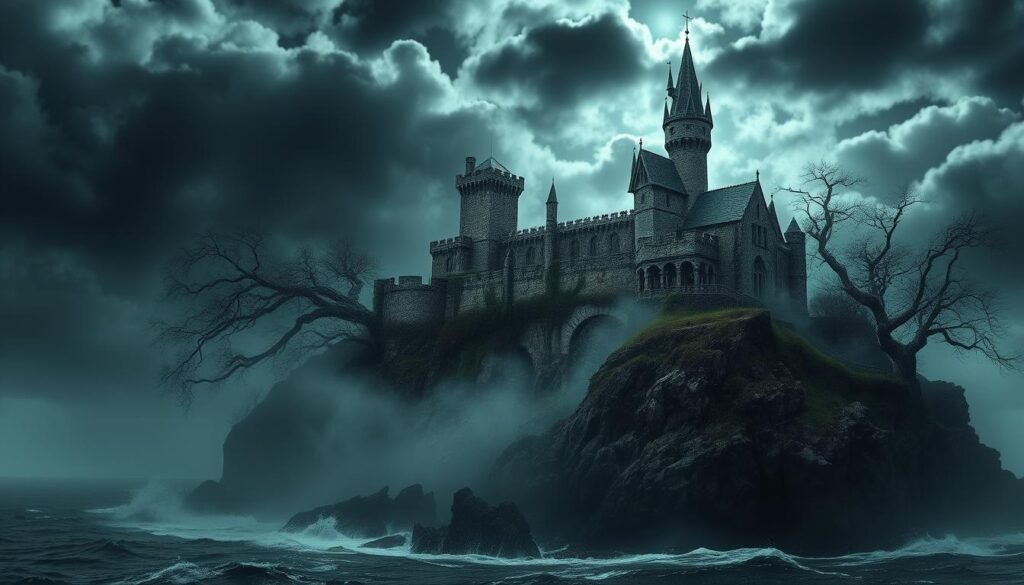
Architectural Features That Evoke Fear and Mystery
Gothic castles have design elements that make stories tense. Their tall spires, winding stairs, and hidden rooms create mystery. Dark halls and flickering lights cast scary shadows. Secret rooms hold secrets, keeping readers guessing.
Famous Fictional Castles in Gothic Romance
Many famous haunted castles appear in Gothic stories. Bram Stoker’s Dracula’s Castle and Edgar Allan Poe’s House of Usher are well-known. These places are linked to fear, leaving a mark on readers for years. Their detailed descriptions take us to worlds where the real and supernatural mix, making Gothic romance a timeless genre.
Misty Moors and Desolate Landscapes
Gothic romance loves to take readers to eerie places. Moors in books are key, making stories feel isolated and full of mystery. These places help set the mood of gothic tales.
Writers often use moors and heaths in gothic stories. These places show characters’ inner struggles and add to the tension. For example, the Yorkshire moors in “Wuthering Heights” make the story feel darker.
Authors are great at describing these lonely places. They write about twisted trees, dangerous bogs, and mist. These descriptions make readers imagine and feel the story.
Moors and heaths in gothic books also mean freedom. But, characters who go there face dangers. Writers use setting to take us to places where anything can happen.
The Gothic City: Urban Shadows and Secrets
The urban Gothic genre shows city life in the Victorian era. It uncovers the dark side of cities, revealing secrets and mysteries. This mix of city life and Gothic elements is very engaging for readers.
Victorian London in Gothic Fiction
Victorian London is the perfect setting for urban Gothic stories. Writers make the city a character, with foggy streets and tall buildings. The narrow alleys and dim streets are great for hiding evil, adding to the mystery.
Dark Alleys and Foggy Streets
Gothic authors use city streets to create tension. Foggy nights and gas lamps cast spooky shadows. These elements make familiar places seem scary, perfect for mysteries.
The Contrast Between Opulence and Squalor
Urban Gothic shows the big social differences of the time. Rich mansions are close to poor slums. This contrast makes stories richer, driving the plot and character growth in city-set Gothic romances.
Isolated Mansions and Country Estates
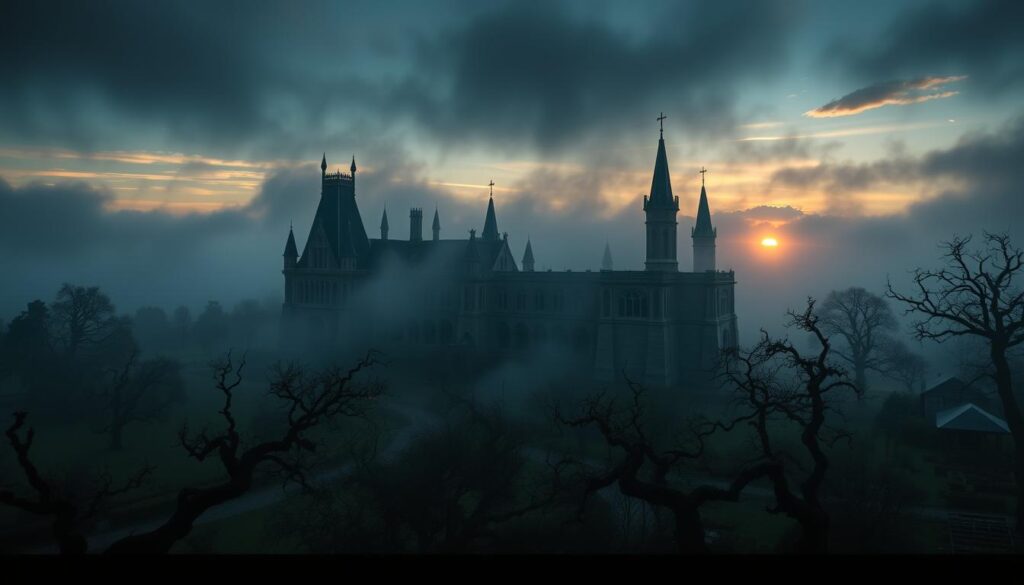
Gothic mansions and grand estates are key in Gothic romance. They are often found in rural areas. This makes them perfect for stories of mystery and intrigue.
The isolation of these places adds to the unease. It creates a great setting for secrets and dark histories to grow.
In Gothic stories, the mansion is like a character. Its corridors and hidden rooms show the complex minds of its owners. The grand estates hide decay, showing the fall of aristocratic families and their sins.
Examples like Thornfield Hall from “Jane Eyre” and Manderley from “Rebecca” are famous. These homes, far from the world, make characters face their fears. The empty rooms and gardens let readers’ imaginations soar.
Nature’s Fury: Storms and Wilderness in Gothic Romance
Gothic romance loves the power of nature. Stormy weather and wild landscapes are perfect for stories of love and mystery. These settings show the turmoil inside characters and move the story in exciting ways.
The Symbolism of Thunderstorms
Thunderstorms in Gothic stories mean more than just bad weather. They show emotional turmoil and danger. Lightning lights up dark secrets, and thunder beats like scared hearts. This makes the story even more thrilling.
Untamed Forests and Their Mysterious Inhabitants
Dense, dark forests are key in Gothic stories. They hide secrets and dangers. Twisted trees and dark paths show characters lost in their own minds.
Strange creatures or hidden villains hide behind trees. This adds to the suspense.
The Sea as a Gothic Element
Maritime Gothic adds a special touch to the genre. The vast, unpredictable ocean symbolizes the unknown. Stormy seas show inner conflicts, and isolated places trap characters.
The danger of drowning or shipwrecks makes seaside stories tense.
Psychological Landscapes: The Inner Turmoil Reflected in Setting
Gothic literature explores the human mind deeply. It uses settings to show characters’ inner worlds. Writers turn normal places into emotional landscapes that show what’s going on inside the characters.
In Gothic romance, characters grow through their surroundings. A dark castle might show the burden of family history. A stormy sea could symbolize the turmoil inside a character.
Authors paint vivid pictures to show fears, desires, and hidden traumas. A character’s inner struggles might be shown as a complex mansion. Each room can reveal a new part of their mind.
The psychological Gothic genre makes stories feel real. Settings and characters blend together. As characters move through their emotional landscapes, readers feel like they’re part of it. This connection makes Gothic romance so engaging and lasting.
Modern Gothic: Adapting Traditional Settings for Contemporary Readers
The Gothic genre has changed a lot since its start. Now, authors are making it fresh for today’s readers. They mix old Gothic stories with city life, creating urban fantasy.
Skyscrapers and old factories are now part of Gothic tales. Writers like Neil Gaiman and Guillermo del Toro have made Gothic stories for today. They show how old Gothic feels can fit in today’s world.
Today’s Gothic stories are about different fears. They’re not just about ghosts anymore. Now, they talk about technology and our minds.
The Gothic genre keeps getting new life. It stays interesting by mixing old and new. This way, it speaks to today’s readers in a new way.

